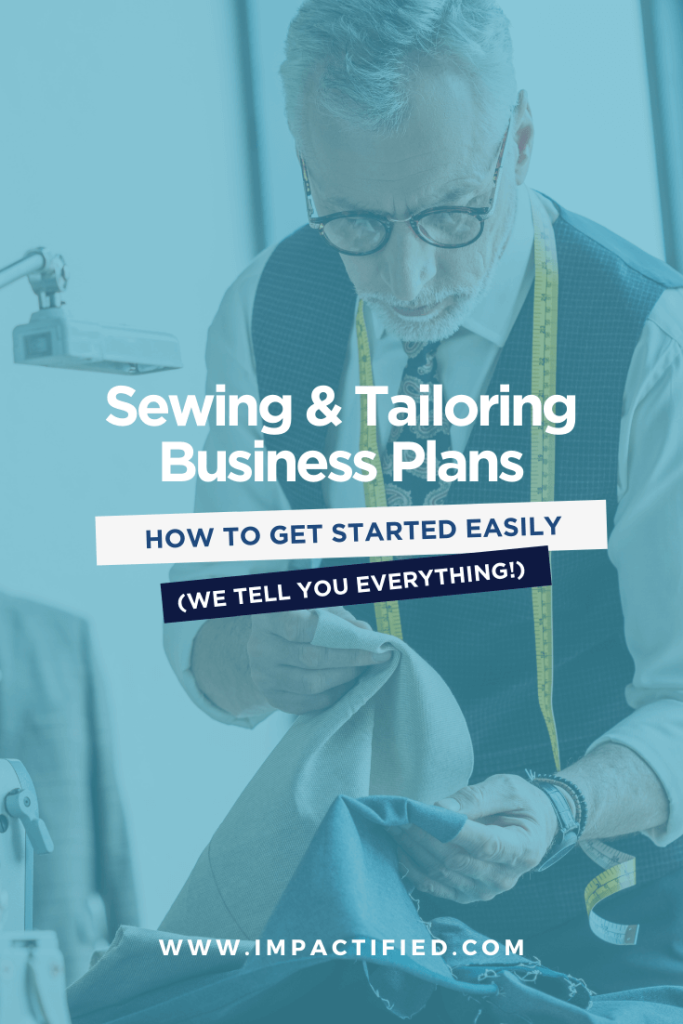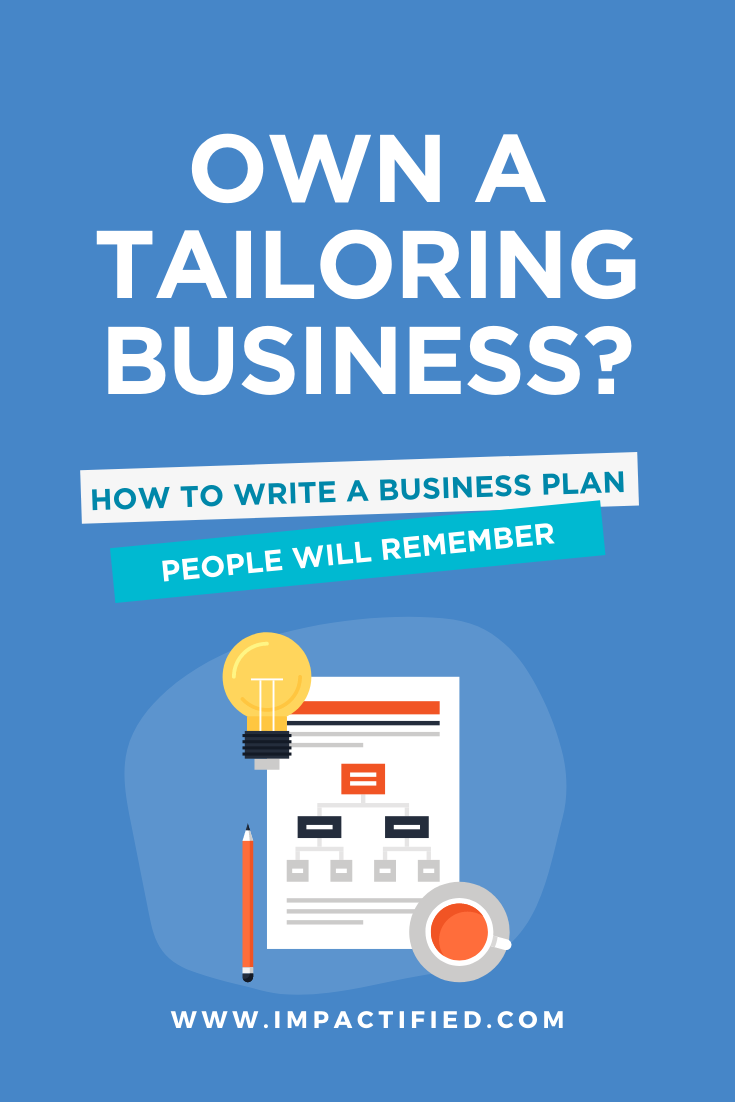(This article was written on 10/10/2020 and updated on 23/03/2022)
If you are reading this page, chances are that you must be looking for a sewing and tailoring business plan template. You probably know all about tailoring already (right?), but something is missing from your equation.
You’re not clear with what boxes you’re supposed to tick, not too sure about the format you’re supposed to use either. In short? You’re in a grey area, and guess what? We’re not surprised.
Truth be told, we – at Impactified – don’t run a tailoring business and we can’t tell you how to become a tailor. BUT, we are entrepreneurs on a mission to help other entrepreneurs and we know how to write a business plan. So we’re happy to share the fun.
As far as business plan writing is concerned, high-caliber tailor shops and sewing alterations business owners all have to abide by the same rules as other businesses. And that means that we can help.
Between you and us, the reality is that something close to five hundred people look for this exact term on Google every month, so you are not alone. Far from it…
The question everyone is wondering about, however, is how to make sewing and tailoring a fancy business for people to invest in. So, in this article, we’re going to try and answer some of your questions, and we’ll also provide you with a very detailed business plan template we’ve written to help you get yourself sorted.
Shameless plug: no, we can’t write your business plan for you, but since we keep receiving requests we developed a specific module (we called it The Business Plan Builder) designed to make your life super easy. It includes templates, a “how to” framework, designer-made decks and a couple of hours of videos – you have no excuse, really.
You should already be insanely turned on by now, but if that’s not the case, that’s okay – just keep reading.
Before getting to the “give me a business plan sample” stage, though, we’d like to provide some background information and food for thought on what business plans are about, and on how you could leverage the exercise.
Yes, at the end of the day, a tailoring business plan could help you with securing a bank business loan, but there’s a lot more to it. For instance, those who ask us how to write a good business plan would very often look for a way to talk to investors, or to reach new partners for their business – tailor or not!
More interesting, however, is the usually forgotten idea that the purpose of a business plan is to make you think about your business in a big picture mode.
In doing so, you not only gain a chance to pitch better, but you also have a major opportunity to think about your business much much much (yes, yes, yes) deeper than ever.
The purpose of a business plan.
Before we get to the question of how to actually write a sewing and tailoring business plan, we’d like to point out that two questions keep coming again and again. One relates to the purpose of a business plan, the other to its ideal formatting. Let us first focus on the former.
The purpose of a business plan is to present your tailoring business in a bankable manner.
To put things very simply, the purpose of a business plan is to present your tailoring shop business plan in a bankable and funder-friendly manner.
Something like that!
Usually, the idea you have in mind is to show the plan to a banker (in order to secure a business bank loan) or to an investor (to secure the capital you can use to develop the business).
The key, however, is to realize that bankers and investors are two very different types of beasts.
Both can bite (be careful), but they think very differently because their own goals are different from one another.
On the one hand, bankers lend money to entrepreneurs and business owners, which by definition means that they intend to get it back within a reasonable amount of time.
On the other, investors invest money on entrepreneurs to bet on their success and hope to obtain a return on their investment within a few years.
Said differently, one wants to be repaid asap whereas the other invests to get a lot more than a repay, later. Can you see the difference in terms of mindset and approach?
What that means is simple: you need to adapt your tailoring business plan to your audience.
If your objective is to secure a loan for your clothes tailoring business, your plan must show that you will be able to repay the debt. Not maybe. Not perhaps. Not if everything goes well. With certainty, at regular intervals, so forth, and so on.
If your objective is to secure an investment, however, then you must demonstrate that there is a potential for profit behind your business proposal. Profit won’t be there right now, it’ll take a few years. But when everything happens as you think it will happen, then there will be a significant return on investment for both sides – yours, and theirs!
The purpose of a business plan is (more importantly) to show that you have a business with a plan – hmmm.
Even more importantly, your tailoring business plan must show that you have a well-considered and sound plan to turn your tailor shop into a better business.
We know, that’s powerful, but bear with us. What we just wrote sounds dull but it really isn’t. In fact, it’s fundamental.
If there’s one thing you want to remember from this article, it’s this one: a business with a plan is worth a lot more than a business plan without a business.
Look – a business plan is nothing but a .pdf document or pitch deck you show to people to try and get what you want. And that tailoring business plan pitch deck of yours has no value whatsoever unless it actually comes with a real dose of strategic thinking as to how you will get your tailoring business to a significant next step. For real!
This implies a few things.
One, you must demonstrate that you carefully considered the big picture of your business. You have analyzed the market. You know your customer, and you are actually able to answer a demand. You have a competitive advantage compared to others. So forth and so on.
Are you an industrial sewing company or a local shop with a local clientele?
What makes you “you”?
What makes you unique for people?
Two, you must demonstrate that you asked yourself the right questions and that you are aware of your own limitations.
Typically, an entrepreneur or shop owner who presents themselves as an invincible superhero who has all the answers to everything will not tick all the boxes. In fact, they’ll sound ridiculous.
Doesn’t look too serious, does it?
If your primary job is to be a tailor, nobody will expect you to have an answer for anything business-wise so sometimes your best bet is to openly admit that you have clearly identified limitations – and a plan to tackle the problem you’re facing. That’s a smart move because you will then be perceived as being a lot more responsible than someone who sees them as an invincible superhero.
Some find this logic a bit counter-intuitive because we are often educated with the idea that we must be the best at everything. But in reality, what matters is your ability to manage risk, hence honesty with yourself and with the funders is key.
To that extent, showing that you have an actual plan – beyond the paper or tailoring business plan pdf you’ve nicely designed – can be a matter of providing an explanation of whatever partnerships you have in mind.
It could also be an explanation of how your business model, cost structure and go-to-market strategy will make your tailoring business a better business.
The purpose of your sewing and tailoring business plan is to make your program logical and sensible. Period!
So your plan is what matters, right? Well, here’s what it means!
Clearly, you need to show them what funding you need, whether to get things started, to get them going, or to get them to the next level. In each case, explain why you’ll be more than fine, and give them a feeling that you are the right person to give the money to.
You should be clear with the typical requirements for a tailoring shop, so be sharp on that side of things (obviously)
More importantly, go the extra mile and show that, beyond knowing how to do the job, you will be able to manage whatever comes next – including the BS and all the trouble you haven’t thought about yet! If reading the tailor’s guide on how to start a tailoring shop was enough, everybody would do that, right?
In short, you really want to show some context and demonstrate that you are the tailor shop to fund in town (did you notice the italic there?).
For instance, show that you have the necessary training, that you know about sewing and fashion design, and show that you have the right experience to not just make your job as a tailor, but also to run the sewing business like a business.
Like an entrepreneur would, we mean.
Explain how “location, location, location” will influence your shop.
Show that the population around your shop has enough means to think “oh, I need a tailor!“.
Show that the equipment you need is the right one and that the customer will have a great experience that’ll make them want to come back.
Why? Because returning customers are a source of recurring income, and that makes a big difference for a finance reader.
Last but not least, don’t forget to talk about you (why you are the best at it) and about your needs in terms of needs. Who do you need to hire? Why? For what type of return on investment? So forth and so on!
Remember, writing a sewing and tailoring business plan goes far beyond just finding a business plan template. It really is a matter of building a story around your shop, and about making sure that people will want to buy in.
In short, the purpose of your sewing and tailoring business plan is to:
- present your tailoring business in a bankable manner
- show that you have a business with a plan
- make your program logical and sensible
Formatting your tailoring business plan.
All right! You’re still there? You’re awesome.
The second big point we wanted to talk about in this article relates to another question we keep having again and again (and again, and again…) relates to formatting. We all wonder about the ideal business plan format sooner or later, and the good news there is that the answer is rather simple.
Your tailoring business plan must be brief, and it must follow a specific code.
We’re exploring the topic of the ideal business plan outline and format in a dedicated article, but to give you the long story short: make it brief, follow the code and tell a story. That’s it.
Make it brief.
Making your business plan a brief one is always a good idea. In fact, not following that rule will get you into trouble.
At the end of the day, whoever is going to have a look at your tailoring business proposal probably has a lot on their plate already, hence anything too long will send your file straight at the bottom of the pile.
Follow the code.
Ultimately, writing a business plan is a matter of understanding a code and applying it scrupulously.
As explained in our “how to write a business plan” guide (keep reading, it’s coming) and in our Business Plan Builder Module, the secret is to fit everything into seven to eight pages – plus the financial tables that will come on top of that.
Those pages must be sharp and spot-on. They must focus on very specific topics organized in a precise way: an executive summary, a big picture presentation, an explanation of the problem (to suggest the existence of a market), followed by a description of the offer. Then the go-to-market strategy, the financial estimates, so forth, and so on.
Tell a story.
Beyond the structure, the point here is that this logical order gives you a chance to tell a great story about your business.
Why would you bother with that? Hmmm, think about it.
So?
Okay.
First reason: people hate reading boring stuff but they love stories. If your business plan looks like a long, boring, dull document written in black on a white sheet of paper on a pile of white-colored paper, then you’re out. Instead, writing your tailoring and sewing business plan as a story that gets people on a journey will make a difference.
Second reason: people want to buy but they hate being sold stuff. Your readers will want to put money in your business if they like your story, not just because you ask for money.
Now of course the difficulty is to turn your business plan into a story, but if you follow the framework we just gave you, whatever you produce should be logical and easy to read. This is precisely what the code is about.
How to format your tailoring business plan:
- Make it brief
- Follow the content code (as explained)
- Turn the plan into a story
Saving your tailoring shop business plan from typical mistakes.
Now, beware of the traps. Your sewing and tailoring business plan must follow the code we just mentioned, but there are also some typical mistakes you absolutely want to avoid.
Don’t be your own reader.
One typical mistake made by many entrepreneurs relates to the fact that you cannot afford not to have an external reader.
Many entrepreneurs read their own business plan again and again until they are happy with it, then they submit the document pdf to whoever they have in mind. And they get it wrong, because they wrote the plan for themselves, not for a reader who doesn’t know the business yet.
The issue is, things that make sense to you won’t necessarily make sense to others. As the entrepreneur in charge, your job is to make sure that anyone would understand what you are trying to do, and that anyone can see that your plan to get there makes sense.
So, don’t be your own reader. Ask someone to read the business plan you just wrote, and ask them to provide harsh criticism, then adjust.
Can they understand what you have in mind? Say, your marketing strategy for instance? Can they see how to improve tailoring business of yours over the next five years? Does the plan actually give them any tailoring business ideas that they might share with you?
If yes, go on, if not, revise. That’s the only way!
Don’t be over-optimistic.
More often than not, entrepreneurs are very optimistic about their numbers.
Too optimistic, though.
Your job here is to explain your cost structure (what are your typical tailoring expenses and financial needs, what are the cash flow previsions for your small business, etc.), your new business model (if any), and what additional costs you plan on making to keep growing.
Do you need to invest in new sewing machines? In new people? In more social media advertising? Are there any other tailoring service providers out there capable of threatening your development?
Did you factor the cost of real estate expenses in the overall plan?
Did you do any market research at all? Is your target market big enough to make those investments sustainable and profitable? Within how much time will the marketing plan produce its first effects? How many suits do you need to sell to cover those expenses?
The idea here is to think in terms of tangible responses that people can understand and relate to. For instance, if selling 10 suits is enough to cover a marketing campaign for your store, then say it!
The point, however, is not to go for the moon. So, don’t be too conservative, find a happy medium between conservative and optimistic. And, of course, be ready to defend your numbers.
In case you were just wondering how to manage the numbers part of your tailoring business plan, the good news is that the Business Plan Builder will help you get those numbers going. Give it a look and go for it, you’ll see.
Act before your tailoring business needs money.
Another mistake entrepreneurs typically make is to wait until it’s too late. Total fail! They start working on their business plan when things get a bit tight, but by doing so they have to face a degree of emergency that blocks their perspective.
So, don’t work on a tailoring business plan because you need the money right now, but invest some time to do that ahead of time.
One, this will give you an amazing chance to think about the big picture, and this will give you great ways to see your business differently.
Two, having a tailoring business plan ready could be a way to actually look for money when you don’t need it. Technically, that would make you even more desirable because people love investing money in people who don’t need any money.
It makes sense if you think about it.
Don’t forget what they want.
The previous point gets me to this one: don’t forget what your interlocutors want. If you are talking to bankers, show them that funding your business is safe and that you will be able to repay the business loan in due time, according to the time schedule agreed upon.
If you are looking for someone willing to invest in your tailor shop, however, make them see what’s in it for them down the road. What will be their return on investment? When will you make money for them?
In both cases, show that there is a product-market fit. Show that the competition is healthy and that you have a distinguishing characteristic that makes you unique. Show that you have a sound financial plan to get there. So forth and so on.
4 typical business plan mistakes to avoid:
- Don’t be your own reader.
- Don’t be overly optimistic
- Act before your tailoring business actually needs money
- Don’t forget what the reader wants
Write your tailoring business plan, easy as 1, 2, 3!
As we mentioned in the introduction, the point of this article wasn’t to show you how to write a business plan per se, but to give you some food for thought as to why writing a tailoring business plan could help your business in ways you didn’t consider.
Now if you’re wondering how to move on with writing yours, here’s a couple of ideas.
Think outside your box & get yourself challenged.
First, If you need a hand to brainstorm about your business, our online business coaches will be happy to assist. Let’s be very clear – they won’t write the business plan for you, but they’ll make you think outside your box, and they’ll put you on track.
[block id=”5106″ title=”book an online coach”]
Leverage the power of the Business Plan Builder.
Having said that, the other option is to get your own tailoring business plan done by yourself – which actually is a good idea for two reasons.
One, it’ll save you thousands of dollars compared to having someone else doing it for you.
And two, you won’t take the risk of looking stupid (ouchies, right?) when someone grills you and you have no idea what the heck they’re talking about.
Now no need to worry – as we said earlier, we can help.
To begin with, our free business plan template guide was written to help you write a tailoring shop business plan that makes more sense than ever. Again, we know, we’re not tailors ourselves, but a business plan is all about structuring so just use the method and add your own spicing. You’ll be just fine, really!
Even better (no kiddin’ bro!) The Business Plan Builder was designed to make your life a lot easier.
- The Module contains two hours of videos (by a business coach) that’ll tell you everything you need to know and do to make your business plan convincing.
- It also contains a real and life-changing business plan work-frame. We tell you what to think about, in what order, and how to write it down. No need to spend hours wondering what on earth you need to write…
- We also provide you with automated financial tables. Not only will you have the tables ready to go (and print), but you’ll also be able to understand the whole process, and to build a financial strategy that makes sense (especially for you!).
- And of course, we provide you with two designer-made templates that you’ll be able to turn your writing into something people will want to read for real.
All that is available at a reduced price for a limited amount of time, so act now before the price goes up again. The module will pay for itself in no time, at that price you really have no excuse.








